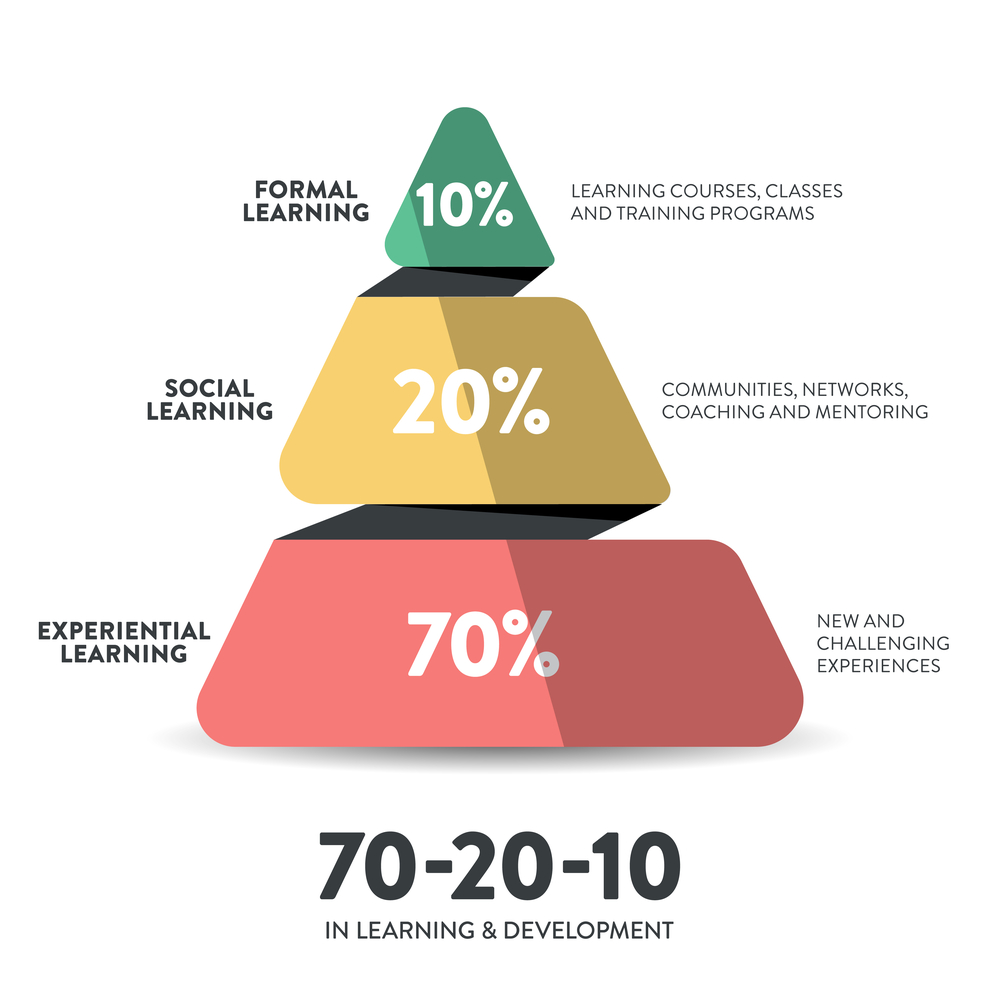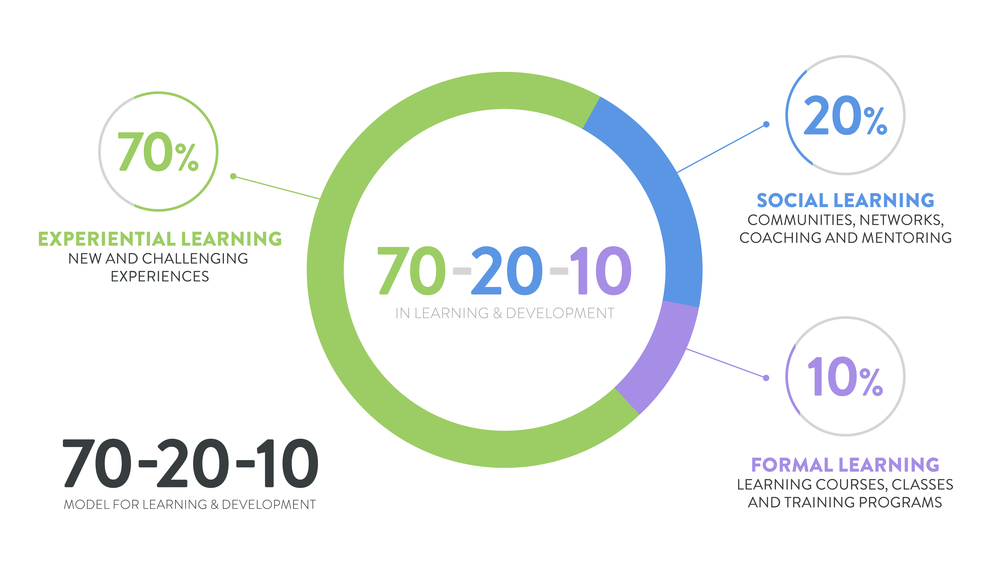The 70-20-10 model for learning and development is a widely adopted framework that helps organizations structure professional development by emphasizing different forms of learning. It proposes that effective learning comes from three primary sources: experiential (70%), social (20%), and formal (10%). The model is valuable for building innovation skills, creativity, transformation, and resilience, as it blends real-world application, feedback from others, and structured education. In this guide we will share examples of applying the 70-20-10 model for learning and development in areas we like to focus on: innovation, creativity, problem solving, collaboration, facilitation, storytelling, etc.
Understanding the 70-20-10 Model for Learning and Development
- 70% Experiential Learning:
- Experiential learning refers to hands-on practice, on-the-job training, and tackling real-world challenges. This is where most learning takes place because it allows individuals to apply concepts in a practical context.
- Examples:
- Creativity and Innovation Skills: Assign team members to innovation projects where they need to brainstorm solutions for real business challenges, creating new products or processes.
- Resilience and Adaptability: Employees can develop these skills by navigating unexpected challenges or changes within projects, allowing them to learn by overcoming obstacles.
- Facilitation Skills: Letting an individual lead a workshop or meeting for the first time enables them to experience facilitation firsthand.
- 20% Social Learning:
- This involves learning from others through mentoring, coaching, feedback, and collaborative work. It also includes learning through conversations, observing peers, and building on collective knowledge.
- Examples:
- Mentoring for Leadership Development: Pairing emerging leaders with experienced mentors to discuss scenarios and strategies helps them learn leadership behaviors through dialogue and observation.
- Peer Coaching for Innovation Mindset: Setting up peer-to-peer coaching sessions to review innovation methods, exchange feedback, and share successes or failures to refine approaches.
- Collaboration in Innovation Projects: Involving people in cross-functional teams to work on innovation challenges promotes learning through diverse perspectives and collaborative problem-solving.
- 10% Formal Learning:
- Formal learning encompasses structured courses, certifications, reading materials, and workshops. It’s a planned approach that gives foundational knowledge, theory, and frameworks.
- Examples:
- Storytelling and Presentation Skills: Taking a storytelling workshop or completing a presentation skills course to learn frameworks for structuring and delivering impactful messages.
- Design Thinking Training: Participating in formal design thinking workshops to grasp the principles of human-centered design and how to apply them in problem-solving.
- Certification in Change Management: Enrolling in change management certification programs to gain structured knowledge on leading organizational transformations.

Applying the 70-20-10 Model in Developing Innovation Skills
1. 70% Experiential Learning Example:
To cultivate creativity and innovation, consider using “Innovation Sprints,” where employees work on generating solutions for organizational challenges. For example, a team working on reducing costs in product delivery might explore new packaging methods and run tests to measure efficiency gains. This hands-on experience deepens their creative problem-solving skills.
2. 20% Social Learning Example:
Establish a Storytelling Circle, where facilitators and leaders meet bi-weekly to share real experiences of using storytelling in workshops or training sessions. They can then offer constructive feedback and new techniques for improvement. This collaborative approach enriches each facilitator’s storytelling capability through peer learning.
3. 10% Formal Learning Example:
Launch an online Innovation Mindset Course that includes video lessons, reading materials, and quizzes. The course could cover topics such as creativity techniques, resilience strategies, and frameworks for approaching transformation. This structured format ensures participants have a solid foundation before they apply these concepts in real-world scenarios.
Why the 70-20-10 Model is Ideal for Innovation and Creativity Development
- Practical Application (70%): Learning by doing is crucial for developing innovation skills because it encourages experimentation and builds the resilience needed to navigate failures.
- Social Feedback (20%): Innovation often involves teamwork and leveraging diverse insights. Peer interactions accelerate learning by exposing individuals to different thinking styles and collaborative problem-solving.
- Formal Knowledge (10%): Structured learning serves as the foundation, equipping individuals with theories and methodologies that guide practical applications and social learning experiences.
Best Practices for Implementing the 70-20-10 Model
- Create a Learning Culture: Encourage employees to embrace continuous learning by integrating learning goals into performance reviews and project outcomes.
- Foster Collaborative Environments: Set up environments where team members can freely share knowledge, brainstorm ideas, and receive feedback.
- Provide Access to Formal Learning: Offer easy access to courses, workshops, and certification programs to ensure that employees have the necessary theoretical foundations.
- Use Real-World Challenges: Assign tasks and projects that mimic real-world complexities to make experiential learning more impactful.
70-20-10 Model for Learning and Development Conclusion
This 70/20/10 rule emerged from decades of Lessons of Experience research from the Center for Creative Leadership. The 70-20-10 model for learning and development is more than just a framework; it’s a strategy for cultivating the next generation of innovators, leaders, and changemakers. By emphasizing real-world application, social interaction, and structured education, organizations can nurture essential skills like creativity, resilience, storytelling, and facilitation to thrive in today’s dynamic landscape.
For more insights into creating a learning and development strategy that supports innovation and transformation, explore our Innovation and Learning Resources. Just contact us if you need help designing and facilitating a L&D or leadership program.
